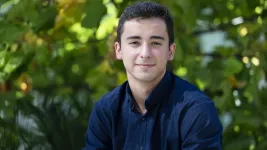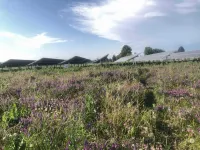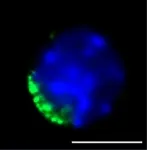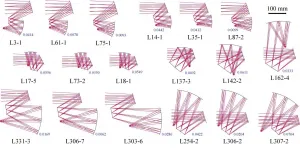(Press-News.org) What started out as a second-year physics project is making its way into Amazon Web Service's (AWS) quantum computing program.
University of Sydney science undergraduate Pablo Bonilla Ataides has tweaked some computing code to effectively double its capacity to correct errors in the quantum machines being designed in the emerging technology sector.
The simple but ingenious change to quantum error correcting code has grabbed the attention of quantum researchers at the AWS Center for Quantum Computing in Pasadena, California, and the quantum technology programs at Yale University and Duke University in the United States.
"Quantum technology is in its infancy, partly because we haven't been able to overcome the inherent instability in the machines that produce so many errors," 21-year-old Mr Bonilla said.
"In second-year physics I was asked to look at some commonly used error correcting code to see if we could improve it. By flipping half of the quantum switches, or qubits, in our design, we found we could effectively double our ability to suppress errors."
The research is published today in Nature Communications.
The results of the study, co-authored by Dr Steve Flammia who has recently moved from the University of Sydney to AWS's quantum computing effort, are to feature in the tech company's arsenal of error correction techniques as it develops its quantum hardware.
Dr Earl Campbell is a senior quantum research scientist at AWS. He said: "We have considerable work ahead of us as an industry before anyone sees real, practical benefits from quantum computers.
"This research surprised me. I was amazed that such a slight change to a quantum error correction code could lead to such a big impact in predicted performance.
"The AWS Center for Quantum Computing team looks forward to collaborating further as we explore other promising alternatives to bring new, more powerful computing technologies one step closer to reality."
QUANTUM ERRORS
Errors are extremely rare in the digital transistors, or switches, that classical computers use to run our phones, laptops and even the fastest supercomputers.
However, the 'switches' in quantum computers, known as qubits, are particularly sensitive to interference, or 'noise', from the external environment.
In order to make quantum machines work, scientists need to produce a large number of high-quality qubits. This can be done by improving the machines so they are less noisy and by using some capacity of the machines to suppress qubit errors below a certain threshold in order for them to be useful.
That is where quantum error correction comes in.
Quantum errors can occur when the qubit flips on its axis. This is dubbed an X-error. Or errors can occur in its wave phase, known as a Z-error. A Y-error is a combination of flip (X) and phase (Z) errors.
An expert in quantum error correction from Duke University, who was not involved with the study, Professor Kenneth Brown, said: "Typically in quantum error correction, we assume that X, Y and Z errors are equally likely. However, this is not the case in real experiments where the errors are biased."
What Mr Bonilla has done is realign every second part of the error code. The code is designed to work across a two-dimensional network of connected qubits and is called a surface code.
QUANTUM CHESSBOARD
You can imagine the surface code like a chessboard. In its original design, the black squares were designated to detect Z-errors and the white squares designated to detect X-errors. But Z-errors are far more common, so much of the error correcting power was wasted looking for less common X-errors.
Rather than have the 'chess squares' alternate ZZZZ to XXXX, the new code flips half of the quantum switches so that each square looks for both types of errors. This new code is referred to as XZZX code, reflecting the redesign of the surface code.
Professor Brown from Duke said: "The XZZX code is remarkable because it performs optimally for any bias by making a simple local transformation on half the qubits that changes X for Z and Z for X."
Assistant Professor Shruti Puri from the quantum research program at Yale University said her team is interested in using the new code for its work.
"What amazes me about this new code is its sheer elegance. It's remarkable error-correcting properties are coming from a simple modification to a code that has been studied extensively for almost two decades," Assistant Professor Puri said.
"It is extremely relevant for a new generation of quantum technology being developed at Yale and elsewhere. With this new code, I believe, we have considerably shortened the timeline to achieve scalable quantum computation."
Co-author Dr David Tuckett from the School of Physics said: "It's a bit like playing battleships with a quantum opponent. Theoretically, they could place their ships anywhere on the board. But after playing millions of games, we know that certain moves are more likely.
"From experiment we know that Z-errors are much more common than X-errors. Pablo has redesigned the code to take this into account and produced a much more powerful result to suppress errors."
RETROFIT FOR INDUSTRY
Co-author and Associate Dean (Research) in the Faculty of Science Professor Stephen Bartlett said: "What's great about this design is that we can effectively retrofit it to the surface codes being developed across the industry.
"Having the code work on a two-dimensional surface is ideal for application in an industry that has historically produced 2D chip designs. We are optimistic that this work will help the industry build better experimental devices."
Co-author Dr Ben Brown from the University of Sydney Nano Institute and School of Physics worked closely with Mr Bonilla on the project. He said: "Building a functional quantum computer is a bit like trying to build the Wright Brothers' plane, and we haven't even gotten off the ground yet.
"Experimentalists are producing the strong, light-weight materials to build the plane, and we've just come up with a more aerodynamic design for the wings that have more lift. We might have just come up with the design that will help large-scale quantum computing take off."
INFORMATION:
Mr Bonilla, a Dalyell Scholar at the University of Sydney, has started his honours year in quantum computing in the School of Physics.
DOWNLOAD photos of Pablo Bonilla Ataides and Ben Brown at this link.
INTERVIEWS
Dr Ben Brown | b.brown@sydney.edu.au | +61 401 860 369
Mr Pablo Bonilla Ataides | via Dr Brown or media adviser
Professor Stephen Bartlett | stephen.bartlett@sydney.edu.au
MEDIA ENQUIRIES
Marcus Strom | marcus.strom@sydney.edu.au | +61 423 982 485
DECLARATION
This work is supported by the Australian Research Council via the Centre of Excellence in Engineered Quantum Systems (EQUS). Ben Brown received support from the University of Sydney Fellowship Program. Access to high-performance computing resources was provided by the National Computational Infrastructure) and the Sydney Informatics Hub, a Core Research Facility of the University of Sydney.
CORVALLIS, Ore. - A new study by Oregon State University researchers found that shade provided by solar panels increased the abundance of flowers under the panels and delayed the timing of their bloom, both findings that could aid the agricultural community.
The study, believed to be the first that looked at the impact of solar panels on flowering plants and insects, has important implications for solar developers who manage the land under solar panels, as well as agriculture and pollinator health advocates who are seeking land for pollinator habitat restoration.
The findings, ...
Durham, NC - When leukemia strikes an older person, it is in part due to the aging of his or her hematopoietic stem cells (HSCs). These immature cells can develop into all types of blood cells, including white blood cells, red blood cells and platelets. As such, researchers have focused on rejuvenating HSCs as a way to treat leukemia.
A new study released today in STEM CELLS adds much to that level of knowledge by showing that the youthful function of rejuvenated HSCs upon transplantation depends in part on a young bone marrow "niche," which is the microenvironment surrounding stem cells that interacts with them to regulate their fate.
"The information revealed by our study tells us that the influence of this niche ...
Ancient clues, in the shape of fossils and archaeological evidence of varying quality scattered across Australia, have formed the basis of several hypotheses about the fate of megafauna that vanished about 42,000 years ago from the ancient continent of Sahul, comprising mainland Australia, Tasmania, New Guinea and neighbouring islands.
There is a growing consensus that multiple factors were at play, including climate change, the impact of people on the environment, and access to freshwater sources.
Now, research led by Professor Corey Bradshaw of Flinders University and the Australian Research Council Centre of Excellence of Australian Biodiversity and Heritage (CABAH) has used sophisticated mathematical modelling to assess how susceptible different species were to extinction - and what ...
April 13th, 2021, Washington, D.C. - The severe health and economic impacts of the COVID-19 pandemic have disrupted food systems and upended livelihoods. Yet pandemic responses have demonstrated the power of well-crafted policies to blunt the impact of major shocks while laying the groundwork for stronger, more resilient food systems, according to the 2021 Global Food Policy Report, released today by the International Food Policy Research Institute (IFPRI). The report provides lessons drawn from the current crisis that can help us transform food systems to reduce the impact of the ongoing pandemic, better prepare for future shocks, and address longstanding weaknesses and inequalities.
"We have known ...
In the early time of optical design, people have to be proficient in aberration theory and perform a huge amount of numerical calculations, and thus mathematical skills and talents are very important. The emergence of electronic computers has freed people from heavy calculation tasks, and realized fast real ray tracing and been able to solve complex aberration equations. Since then, the application and development of optimization algorithms and optical design software have greatly improved the speed and effect of optical design. However, optical design still requires to solve or find an initial solution as the starting point of optimization, which will greatly determine the final result of optimization. Moreover, optimization is essentially ...
The top priority in the field of transplantation is to ensure that donor organs are allocated to the patients with the greatest need.
In a large-scale joint international project conducted by the Medical University of Vienna and the Mayo Clinic in Rochester (USA), researchers from the Department of General Surgery and the Division of Gastroenterology and Hepatology of MedUni Vienna's Department of Medicine III, have made a significant step forward to improve prediction of survival on the waiting list for liver transplantation by including additional laboratory parameters.
Donor ...
In recent years the boom in streaming platforms and video on demand services has led to disruption in audiences, representing a difficulty when measuring the number of viewers of the content distributed by these platforms.
This new situation has not only altered the traditional television and film viewing model, but also has impacted the advertising market, which is a fundamental factor in funding and the business of audiovisual entertainment.
In this context, real and objective audience measurement (which is not influenced by the interests of the platforms) has become a key objective; it is fundamental to obtain real-time data on the reach of each production ...
When trees die during a period of drought, they die of thirst. Researchers from the University of Basel have demonstrated in a field study that a rapid collapse in the hydraulic system is responsible for tree death. And they found out that the trees possibly die more rapidly than previously thought.
The heatwave of summer 2018 was an exceptional situation - both for nature and for research. Although admittedly hard on our native woods, it also presented an opportunity for researchers at the University of Basel to closely study the reaction of trees to this weather phenomenon.
The research group led by Professor Ansgar Kahmen had already set up a research area in the Basel-Landschaft municipality of Hölstein the previous year. Their aim was to study the tree ...
Misinformation in public debates about scientific issues such as vaccinations and climate change can be found all over the internet, especially on social media. In a new study, Sara K. Yeo, associate professor of communication at the University of Utah, examines why it's so difficult to detect science misinformation and suggests that using humor may help combat the issue.
In the article, published in Proceedings of National Academics of Sciences, Yeo and her colleague Meaghan McKasy, assistant professor of communication at Utah Valley University, argue that limited science and media literacy combined with structural constraints such as fewer ...
Low-dimensional colloidal quantum dots (CQD) have attracted significant attention because of their unique structures, extraordinary optical properties, and low-cost preparation processes. Since its first synthesis in the 1990s, motivation to realize high-performance low-cost CQD micro-/nanolasers have been a driving force for more than three decades. However, the low packing density, inefficient coupling of CQD with optical cavities, and the poor thermal stability of miniaturized complex systems make it challenging to achieve practical CQD micro-/nanolasers, especially to combine the continuous working ...





